化学处理天然纤维纺织增强胶凝复合材料耐久性试验研究
IF 7.4
1区 工程技术
Q1 CONSTRUCTION & BUILDING TECHNOLOGY
引用次数: 0
摘要
纺织增强胶凝复合材料(trcc)代表了轻量化结构的重大进步,尤其适用于加强和改造结构元件。在这种背景下,天然纤维基纺织增强胶凝复合材料(ntrcc)作为传统纤维增强复合材料的可持续和经济的替代品已成为新兴的焦点,具有高度特异性的性能。尽管有这些优点,但由于现有的研究有限,ntrcc的长期力学性能尚未完全了解。本研究旨在评价化学改性天然纤维基纺织增强胶凝复合材料的长期力学性能。苎麻和黄麻纺织品,每一种都有三种不同的网格尺寸(5 毫米,10 毫米和15 毫米),用作增强材料。化学改性,如碱性处理,用于预处理相应的纤维,以解决水泥基质中纤维敏感性等问题。为了评估ntrcc的耐久性,在冻融(FT)、热雨(HR)、碱性(AK)和氯化物(Cl)等不同环境下进行了加速老化试验。暴露在这些条件下的样品进行单轴拉伸试验,并进行微观研究,以分析暴露后复合材料内纺织品的变化。此外,裂纹模式在老化的试样进行了检查。结果表明,苎麻纺织复合材料的性能优于黄麻纺织复合材料。暴露于Cl环境下的试样表现出提高的平均力学性能(20-25 %),可能是由于纤维-基质界面盐层的生长。相反,碱性环境会导致复合材料性能的显著下降。总的来说,处理过的纺织复合材料表现出优异的耐久性,比未经处理的纺织复合材料保持大约20% %的强度。本文章由计算机程序翻译,如有差异,请以英文原文为准。
Experimental investigation on durability of chemically treated natural fiber textile reinforced cementitious composite
Textile-reinforced cementitious composites (TRCCs) represent a significant advancement in lightweight construction, especially ideal for strengthening and retrofitting structural elements. Within this context, natural fiber-based textile-reinforced cementitious composites (NTRCCs) have become an emerging focus as a sustainable and cost-effective alternative to conventional fiber-reinforced composites, offering highly specific properties. Despite these advantages, the long-term mechanical performance of NTRCCs is not fully understood as the studies available are limited. The present study aims to evaluate the long-term mechanical performance of chemically modified natural fiber-based textile-reinforced cementitious composites. Ramie and Jute textiles, each comprising three different grid sizes (5 mm, 10 mm, and 15 mm), are used as reinforcements. Chemical modifications, such as alkaline treatment, are employed to pre-treat the respective fibers to address concerns such as fiber sensitivity within cement matrices. To evaluate the durability behavior of NTRCCs, accelerated aging tests are conducted under distinct conditions, including freeze-thaw (FT), heat–rain (HR), alkaline (AK), and chloride (Cl) environments. Specimens exposed to these conditions undergo uniaxial tensile tests, and microscopic studies are performed to analyze changes in the textiles within the composite after exposure. Additionally, crack patterns in aged specimens are examined. It is found that the ramie textile composites outperformed the jute textile composites. The specimens exposed to the Cl environment exhibit enhanced mean mechanical performance (20–25 %), likely due to the growth of a salt layer at the fiber-matrix interface. Conversely, the alkaline environment causes significant degradation in composite performance. Overall, treated textile composites demonstrate superior durability, retaining approximately 20 % more strength than untreated textile composites.
求助全文
通过发布文献求助,成功后即可免费获取论文全文。
去求助
来源期刊

Construction and Building Materials
工程技术-材料科学:综合
CiteScore
13.80
自引率
21.60%
发文量
3632
审稿时长
82 days
期刊介绍:
Construction and Building Materials offers an international platform for sharing innovative and original research and development in the realm of construction and building materials, along with their practical applications in new projects and repair practices. The journal publishes a diverse array of pioneering research and application papers, detailing laboratory investigations and, to a limited extent, numerical analyses or reports on full-scale projects. Multi-part papers are discouraged.
Additionally, Construction and Building Materials features comprehensive case studies and insightful review articles that contribute to new insights in the field. Our focus is on papers related to construction materials, excluding those on structural engineering, geotechnics, and unbound highway layers. Covered materials and technologies encompass cement, concrete reinforcement, bricks and mortars, additives, corrosion technology, ceramics, timber, steel, polymers, glass fibers, recycled materials, bamboo, rammed earth, non-conventional building materials, bituminous materials, and applications in railway materials.
 求助内容:
求助内容: 应助结果提醒方式:
应助结果提醒方式:


